

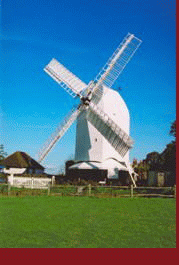




  |
 |
   |
 | ||
      |
  |
| www.oldlandwindmill.co.uk |
| Diary Volume 1 December 2002 to August 2005 |
| Oldland Windmill is an 18th century post-mill situated in the village of Keymer in the County of West Sussex. She is currently being restored to full working order by a dedicated team of local volunteers. |
|
 |
| August 2005 The last Diary entry at the end of 2004 said that we had got the DEFRA grant for the sweeps and brake wheel to be made by a millwright. Lots of investigation has been undertaken regarding the most suitable wood for the sweeps and also what was available. We eventually settled on laminated larch. The stocks and whips for the sweeps are now on order and we hope to see them before the end of the year. The segments for the brake wheel are made from 5" and 3.5" thick elm. We did get quotes for this but decided to look at an elm that had been given to us by Brighton and Hove Council after the hurricane in 1987. It had been sawn into the right thickness and stacked correctly but, over the years, had lain on our site neglected. The top layers were rotten and there was quite a bit of worm on the edges. The lower planks in the stack looked better and, when we had sawn off an end, we were pleased to find nice pink and sound timber. We managed to cut out enough sound segments, the millwright is pleased with it, and it is now in his workshop. |
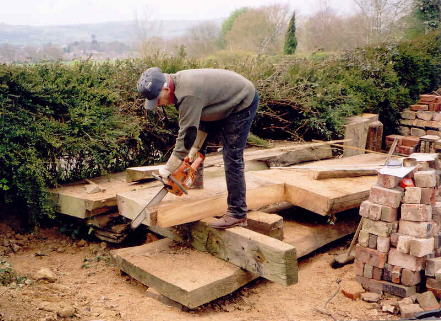 David cutting segments of elm for brakewheel |
|
In January we started on the roundhouse floor. This had suffered from a lot of subsidence. The bricks were removed and cleaned then six inches of soil were removed and replaced by shale. Roy then re-laid the bricks, in the same pattern, on a bed of sand with a little lime mortar added. It was a treat to see an expert at work, every brick laid with a level in two directions. No doubt good enough for a game of bowls. We had to get the millstones out of the round-house to do the floor but also needed them out as Plumpton College have offered to use their blacksmiths to re-band them as a practical exercise. |
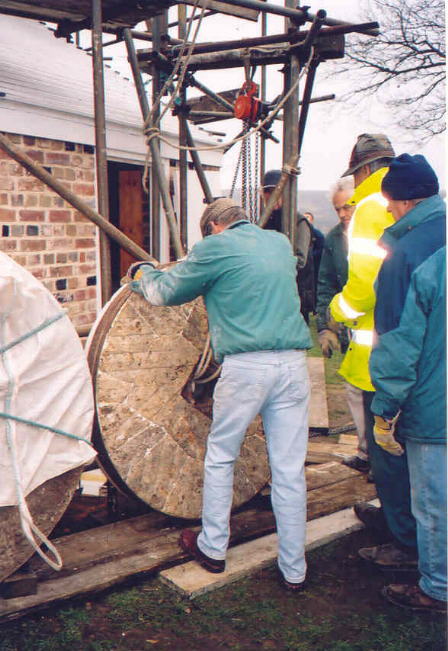 Moving the millstones out of the roundhouse |
In February and March we fitted heavy iron straps over the trestle to hold it to the brick piers. |
|
|
Since April we have been clearing the site. The old timber store is now demolished, lots of old rotten timbers taken away and bare patches sown with grass seed. Not a lot we can do at the moment on the restoration until we can install the new brakewheel. Everything follows on from then, millstones put back, machinery put together, top floor to be made. On Sunday 8th May we had our first open day of the year. A GOOD DAY, lots of visitors, raised a few hundred pounds, Roy's barbeque doing a roaring trade. THURSDAY 2nd JUNE 2005 was a special day. We rotated the mill. Only a few feet, we cannot lift the steps as we do not have the lever on the tailpole, and used rollers under the bottom step. But it moved quite smoothly, a bit stiff to start but, as far as we know, it has not been rotated since the mill stopped working in 1912. The next week, feeling bold, we rotated the mill 180 degrees. This showed up that the post is not quite upright. After this is corrected we can then take measurements from the body to the roundhouse roof and complete the cladding down to the roundhouse. We had another open day on Sunday 10th July. Lots of visitors and raised some much needed money. So far this year there has not been much progress to see but a lot is going on in the background. We should see the timber for the sweeps before long, a contract for the construction of the brake wheel has been given, Plumpton College are re-banding the millstones and making iron rods to support the tailpole to the top of the mill. When any of these are complete then we will have plenty to get on with. D.A.F. 3-8-05 |
| November 2004 |
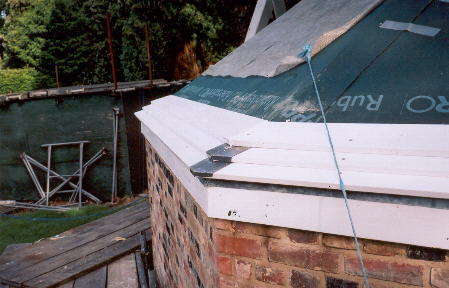
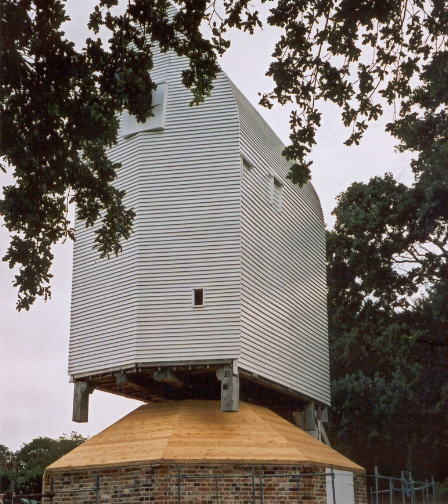 |
|
19th October 2004 Copy of Press Release :- |
| OPEN DAY SUNDAY 26 SEPTEMBER 2004 1100 TO 1600 HOPE TO SEE YOU THERE. BARBEQUE PLANNED. DAF 4/9/04 |
| Sunday 8th August was an Open Day. Lots of visitors, not all local, very hot, raised some money, good time had by all. DAF,19th August 2004 |
Tuesday 8th June 2004 June 2004. Old drawings taken of the round house roof are not very detailed as to dimensions. Lot of mocking up with scraps of timber to make sure that there will be enough room at the peak of the roundhouse to get the millstones through. The Dumbrell Trust donated the money for the roundhouse oak frames and softwood weatherboarding. By the 5th August the roof timbers were in place with much help from Roy Short. The next stage was to close board the roof which was finished 12th August. Now we have to cover this with a breathable membrane ( told this would be better than roofing felt) fix battens and then put on the weatherboarding. Back to sanding, knotting, undercoating and top-coating ANOTHER great pile of weatherboards. |
 Roundhouse walls completed 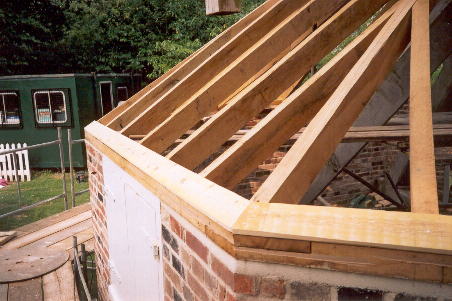 Roundhouse roof rafters |
|
| 14th May 2004 The steam engine came to naught. The Arrangement was that we could use it if I assembled it and provided a boiler. However he telephoned me one morning and said he had sold it without even giving me the option to match the price. So we are back to square one. We are still looking for a stationary steam engine and boiler, not sure of the power required, does anyone know the Brake horsepower required to turn one pair of mill stones whilst grinding wheat? I should guess it would be something with a bore of 5" by 7" stroke running at 150 rpm at a steam pressure of 100 psi. If you know better then please let me know. We have not been idle over the winter even if this website has been. Four new beams were mortised and tenoned into place to support the millstones. Yesterday, 13th May, was a good day and not because it was my birthday but because we (well Roy) started laying the brickwork for the roundhouse walls, made a good start, watch this space. 20th May was a GREAT DAY. We took down the last of the scaffolding, been up since March 2001, and Oldland Windmill is revealed in all her glory. |
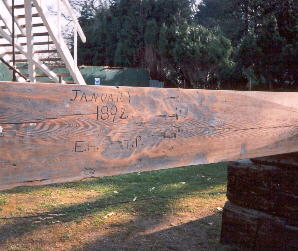 The 1892 tailpole 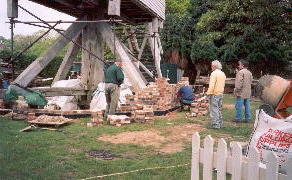 The Roundhouse walls |
|
| December 2003 Welcome to our visitors to this website from Australia. It was decided to use lime mortar to rebuild the walls of the octagonal roundhouse, not for any technical merit but because it was as it was. This posed problems as none of us had used it and a lot of research was required. By then the frosts were about so it was decided to leave the brickwork till the spring. We have been busy our usual one and a half days per week but not a lot to show for it. At least we can now work inside in all weathers. Sunday August 10th we had an open day, hottest day of the year, good number of visitors and raised a few hundred pounds.
In the 1800s a steam engine was used to power the front pair of stones on windless days. We have found a suitable stationary steam engine, we had a very nice old cast iron chassis on site and all we (I) have to do is find a boiler and put it all together. DAF 23-12-2003 |
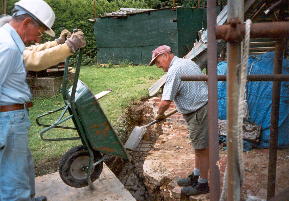 Roy pouring the foundations 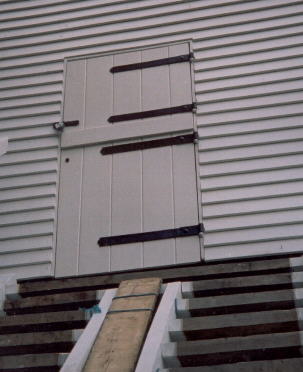 New stable door |
|
August 2003 May saw the two old sprattle beams hoisted out of store on to the stone floor. The old steps to the stone floor were retreaded and put in position. By mid June all the mill body had been given a third and final top coat. By the end of July we had started pouring concrete for the roundhouse foundations and is now completed. Roy Short, a retired local builder of note, has joined our team and next week we hope to make a start on the brickwork for the roundhouse. DAF 7th August 2003 |
 Repaired Spout Floor ladder |
|
April 24th 2003 We have the hatch above the windshaft on the breast of the mill to make and also the weather seal round the windshaft. Next is to put another two topcoats of paint on and the scaffolding can come down. We have started digging to make new foundations for the roundhouse walls. D.A.F. 24/4/03 |
|
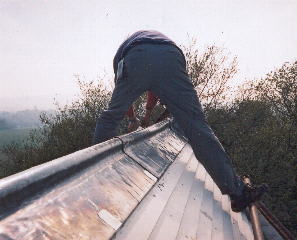 Gerry on a roll |
February 2003 The bottom floor (spout floor) has been floored with 1" pine but not yet nailed as it has to be treated with preservative another reason is we do not want to nail it until we are sure there are no more jobs to do under the floor. Next task is to make the main stable door.D.A.F.17/2/03 |
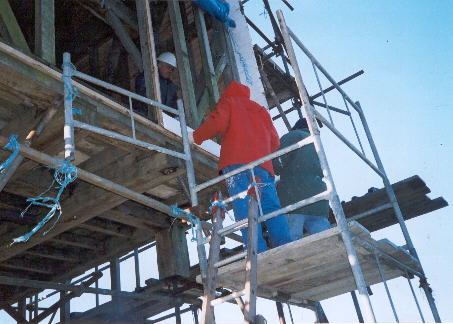 |
|
 |
 |
   Click here to visit Techpoint website |